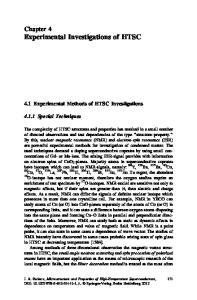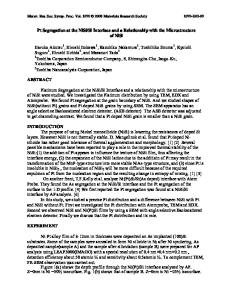Experimental investigations and thermodynamic descriptions of the Ni-Si and C-Ni-Si systems
- PDF / 297,845 Bytes
- 10 Pages / 612 x 792 pts (letter) Page_size
- 107 Downloads / 547 Views
I. INTRODUCTION
KNOWLEDGE of the phase diagram and thermodynamic properties of the C-Ni-Si-Cr-Ti quinary system is of fundamental importance in many applications such as joining of SiC with Ti-modified Cr-Ni brazes,[1–4] ohmic contacts in integrated circuits,[5] structural application under severe conditions,[6] cemented carbide cutting tools,[7] and selfpropagating high-temperature synthesis.[8,9] The knowledge is also needed for an understanding of the interfacial reactions at the SiC-M (M 5 Ni, Cr, and Ti) and TiC-M 8 (M 8 5 Ni and Cr) interfaces.[10,11] However, the phase diagram data for most of the subsystems in the quinary system are limited, and no experimental information is available regarding the quinary system. The determination of phase diagrams and thermodynamic properties can be achieved with relatively few experiments by means of the calculation of phase diagrams (CALPHAD) method.[12] The application of this method can be used to check for internal consistence between thermodynamic and phase diagram data and to provide optimized thermodynamic parameters. The calculated ternary phase diagrams and thermodynamic quantities, based on the descriptions of constituent binaries, make it possible to design experiments most efficiently. The same is true of going from a ternary to a quaternary system, and so on. Consequently, in our group, a research project to establish the phase diagrams of the CNi-Si-Cr-Ti quinary system and its constituent ternaries and quaternaries, by using both experiment and thermodynamic modeling, is in progress.[13,14] In this article, we report on the experimental investigations and thermodynamic modeling for the Ni-Si and C-Ni-Si systems. In the modeling of the ternary system, the thermodynamic parameters for the Si-C and Ni-C systems are taken from YONG DU, Postdoctoral Fellow, and JULIUS C. SCHUSTER, Professor, ¨ are with Institute of Physical Chemistry, University of Vienna, Wahringerstrasse 42, A-1090 Wien, Austria. Manuscript submitted October 13, 1998.
METALLURGICAL AND MATERIALS TRANSACTIONS A
¨ the evaluations by Grobner et al.[15] and Lee,[16] respectively. It is of interest to note that the data recently published by Oden and Gokcen[17] confirm the description by Lee. Recent thermodynamic evaluation of the Ni-Si system was conducted by Lindholm and Sundman,[18] whose optimization was based on the assessment from Nash and Nash.[19] However, the phase diagram data published by Lebaili and Thibault[20] were not covered in the assessment by Nash and Nash. Most recently, the enthalpies of formation at 1200 8C for the compounds Ni2Si (d) and Ni5Si2 (g) have been measured by Meschel and Kleppa[21] using direct synthesis calorimetry. A routine experimental check to verify the findings of Lebaili and Thibault near 25 at. pct Si corroborated their data rather than the assessed version of Nash and Nash. Therefore, a thorough reevaluation of the Ni-Si system was believed to be necessary in order to provide a reliable basis for thermodynamic extrapolations and calculations in relat
Data Loading...











